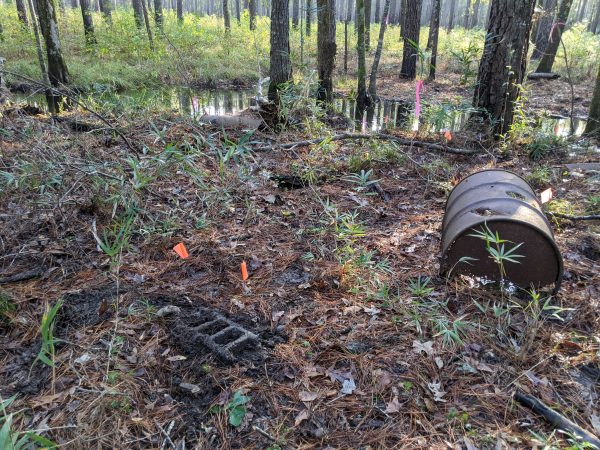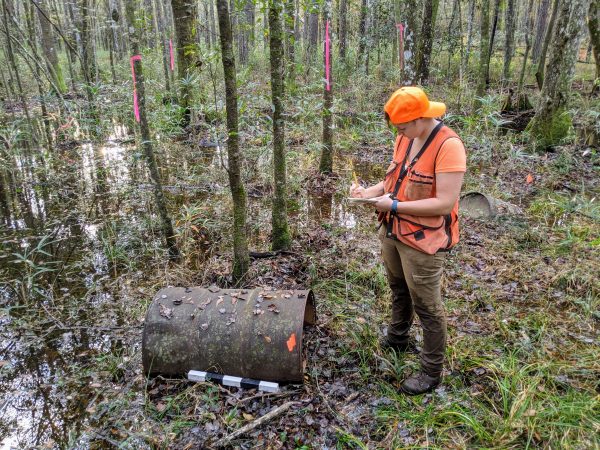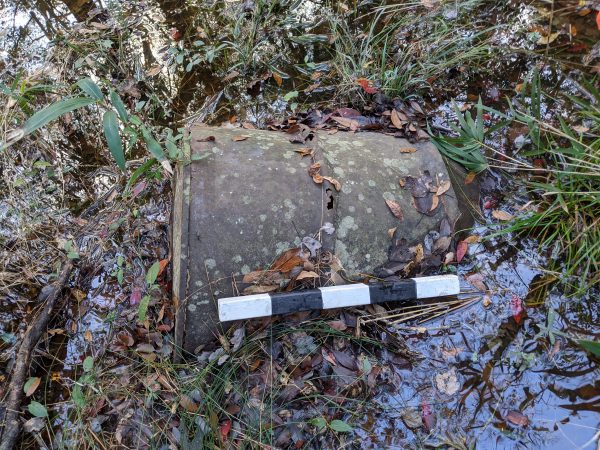By Katherine G. Parker, Doctoral candidate, Department of Anthropology, University of Tennessee, Knoxville
When first I met with Bob Morgan, then the Heritage Program Manager for Francis Marion National Forest (FMNF) in South Carolina, in 2019 to discuss my interest in researching families involved in moonshining on land that the Forest Service now owned, he warned me that there wouldn’t be much left. The Bureau of Forestry, which had preceded the US Forest Service, had bulldozed every remnant of human activity on the landscape that they could find when they acquired the land from declining timber companies in the mid-twentieth century. Yet despite the Bureau’s best efforts to scrub the forest clean of thousands of years of the past (and fortunately for this project), dozens of seemingly innocuous piles of metal are still crouched along the banks of streams that are too small to be found on most maps, littered across a stretch of the forest near Hell-Hole Swamp (Figure 1).

Figure 1. View of a typical moonshine still site on the Francis Marion National Forest in Berkeley County, South Carolina.
Given the swampy, low-lying nature of the setting where moonshine stills are often found, it is unsurprising that these sites evaded the mechanical sweeps that cleared away other anthropogenic traces. Even for many archaeologists today, these sites continue to be missed, overlooked, or written off as not worth the effort—and admittedly, the residual collection of rusting barrels along the murky waters of Cane Gully Branch are easily dismissed. At first glance, these sites do not immediately evoke the sense of importance or industry that they once commanded as the core production center for Al Capone’s Southern moonshining capital (The Charleston News and Courier 1972; Miles 2015; Fleming Smith 2020; McCray 2021). Of even greater concern is that, because of the very environmental situations that allowed these sites to evade detection from law enforcement and federal machinery, these archaeological resources now face an even greater threat: climate change.
Documenting Moonshine in the South Carolina Lowcountry
The FMNF Still Sites project began in 2019 to identify, document, and interpret the extent of moonshining in this portion of the Lowcountry. In the years since, the project has identified several additional moonshine still sites in the vicinity of Hell Hole Swamp, conducted test unit excavations at two of them, and begun developing a series of identification criteria and recommendations to aid archaeologists who encounter still sites on routine surveys. One of the challenges faced by our team as we’ve worked to comb the FMNF for new still sites has been our ability to conduct delineations when these sites are actively flooded (Figure 2). The degree of flooding varies widely at these still sites depending on the time of year and on climatic events that force overflow from higher order river drainages into the intermittent stream channels that moonshiners historically favored. During our November 2020 survey, for example, we were forced to postpone delineations and subsurface testing at two sites that were flooded with 6-14 inches of water deposited by Hurricane Eta (by then a tropical storm; Figure 3). According to NOAA, November 2020 proved to be a record-breaking hurricane season for the Atlantic with 30 named storms—the largest count on record since 2005 (NOAA National Centers for Environmental Information 2020).

Figure 2. Archaeologist Katherine Parker documents one of the barrels from a partially flooded moonshine still site on the Francis Marion National Forest.

Figure 3. Archaeologists Kiersten Weber (background, left) and Jordan Schaefer (right) measure site boundaries at a flooded still site during the November 2020 survey after Tropical Storm Eta.
Given that material culture remains that we find at still sites are primarily metal, the frequent wet-dry flooding cycles post a particularly high risk for site loss (Figure 4). The lack of stable environmental conditions exacerbate the oxidation process that degrades these metal artifacts, which in turn drastically accelerates the rate at which the metal breaks down. Because most moonshine stills are identified by the presence of above-ground debris, the most obvious of which are metal barrels and buckets, the loss of these visible markers means that future stills in coastal settings may never be recorded.

Figure 4. Cyclical flooding episodes from climatic events like Tropical Storm Eta threaten the stability of metal artifacts, such as the barrel shown here, on coastal moonshine still sites.
The Importance of Coastal Moonshine
Moonshine has long been a popular subject for the public, as indicated by the wide range of movies, reality television shows, culture icons such as Gator McKlusky, Popcorn Sutton, and Tickle, and the growing heritage tourism industry centered around Southern moonshining. However, these depictions have shaped our view of who makes moonshine and where; when we think about moonshining, we often think of rural mountain hollers, of wily men with long beards and overalls (or slick suits and fast cars). Rarely do we think about the fact that moonshine was made everywhere, by individuals with different racial, class, and gender identities—spanning centuries of American history rather than the mere 13 years of national Prohibition and intervening decades since. Stories about individuals like Nathan “Nearest” Green, a formerly enslaved man and moonshiner from Lynchburg, Tennessee who taught Jack Daniels the charcoal filtration method that defines Tennessee whiskey today (Risen 2016; Weaver 2019; Uncle Nearest, Inc. 2022), highlight the gaps in what we think we know about moonshining in the past.
As archaeological sites, still sites present the opportunity to better understand divergent histories of moonshining beyond well-trod hillbilly stereotypes—but only if they last long enough for archaeologists to find them.
Interested in learning more about the archaeology of moonshining in the South Carolina Lowcountry? Hear more during the North American Heritage at Risk (NAHAR) virtual lecture on Friday, June 9th, 2023 at 9 am EST.
Citations:
Fleming Smith, Rachel
2020 SC’s Moonshine Culture and Its Long, Bullet-Riddled History. The Post and Courier January 10, Online Edition edition. https://www.postandcourier.com/news/scs-moonshine-culture-and-its-long-bullet-riddled-history/article_33cdd40e-1ac0-11ea-adc4-1fed09721275.html.
McCray, Shamira
2021 Booze for Al Capone: Archaeologists Study SC Illegal Moonshine Sites near Charleston. The Post and Courier February 18, Online Edition edition. https://www.postandcourier.com/news/booze-for-al-capone-archaeologists-study-sc-illegal-moonshine-sites-near-charleston/article_00b4f422-5745-11eb-adc8-9b04476abb1e.html.
Miles, Suzannah
2015 Moonshine Over Hell Hole Swamp. Charleston Magazine December. http://charlestonmag.com/features/moonshine_over_hell_hole_swamp.
NOAA National Centers for Environmental Information
2020 Monthly Tropical Cyclones Report for November 2020. Electronic Document. December. https://www.ncei.noaa.gov/access/monitoring/monthly-report/tropical-cyclones/202011.
Risen, Clay
2016 Jack Daniel’s Embraces a Hidden Ingredient: Help From a Slave. New York Times June 25.
The Charleston News and Courier
1972 Hell Hole Swamp Festival Scheduled for Jamestown. The Charleston News and Courier April 23.
Uncle Nearest, Inc.
2022 Our History. Electronic Document. Uncle Nearest Premium Whiskey. https://unclenearest.com/history/.
Weaver, Fawn
2019 The Story of Nearest Green. Short Film. The Nearest Green Foundation. https://www.nearestgreen.com/animation-and-motion-graphics/the-story-of-nearest-green/.

